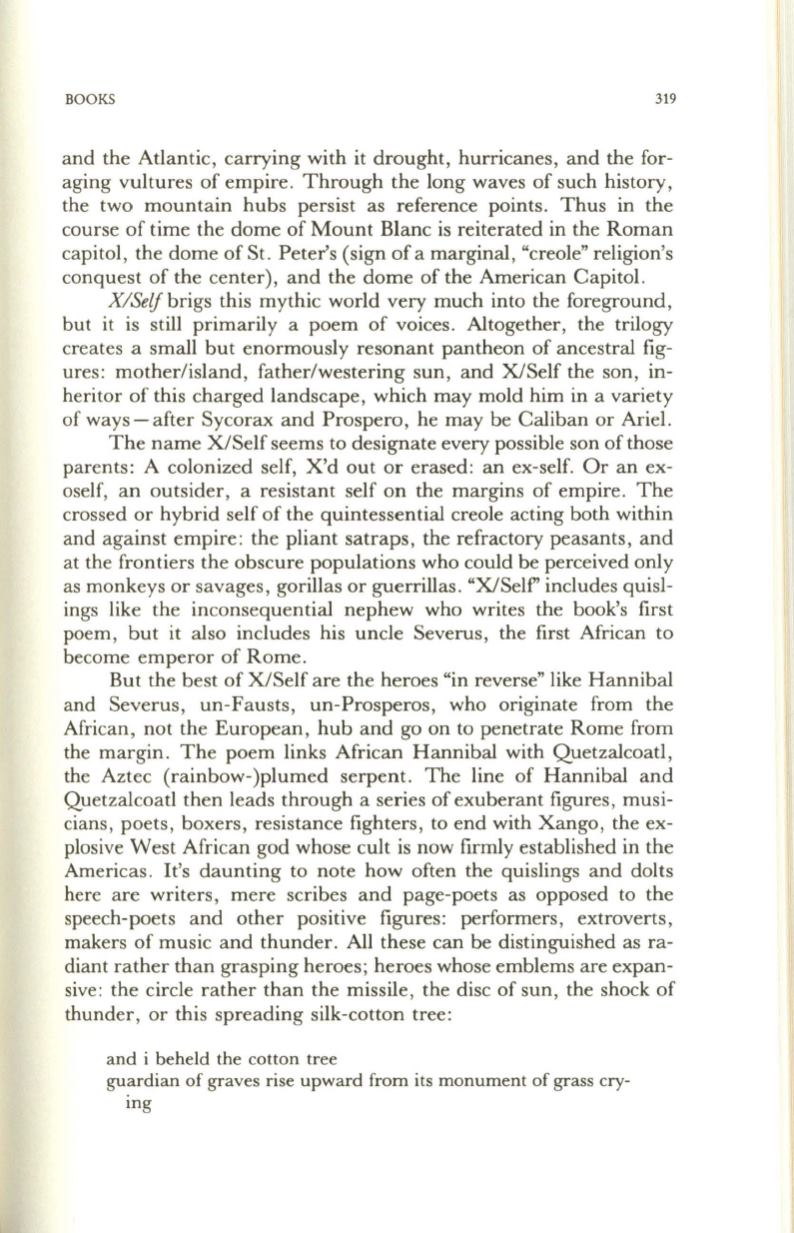
BOOKS
319
and the Atlantic, carrying with it draught, hurricanes, and the for–
aging vultures of empire. Through the long waves of such history,
the two mountain hubs persist as reference points. Thus in the
course of time the dome of Mount Blanc is reiterated in the Roman
capitol, the dome of St. Peter's (sign of a marginal, "creole" religion's
conquest of the center), and the dome of the American Capitol.
X/Self
brigs this mythic world very much into the foreground,
but it is still primarily a poem of voices. Altogether, the trilogy
creates a small but enormously resonant pantheon of ancestral fig–
ures: mother/island, father/westering sun, and XJSelf the son, in–
heritor of this charged landscape, which may mold him in a variety
of ways - after Sycorax and Prospera, he may be Caliban or Ariel.
The name X/Self seems to designate every possible son of those
parents: A colonized self, X'd out or erased: an ex-self. Or an ex–
oself, an outsider, a resistant self on the margins of empire. The
crossed or hybrid self of the quintessential creole acting both within
and against empire: the pliant satraps, the refractory peasants, and
at the frontiers the obscure populations who could be perceived only
as monkeys or savages, gorillas or guerrillas. "XJSelf' includes quisl–
ings like the inconsequential nephew who writes the book's first
poem, but it also includes his uncle Severus, the first African to
become emperor of Rome.
But the best of XJSelf are the heroes "in reverse" like Hannibal
and Severus, un-Fausts, un-Prosperos, who originate from the
African , not the European, hub and go on to penetrate Rome from
the margin. The poem links African Hannibal with Quetzalcoatl,
the Aztec (rainbow-)plumed serpent. The line of Hannibal and
Quetzalcoatl then leads through a series of exuberant figures, musi–
cians, poets, boxers, resistance fighters, to end with Xango, the ex–
plosive West African god whose cult is now firmly established in the
Americas . It's daunting to note how often the quislings and dolts
here are writers, mere scribes and page-poets as opposed to the
speech-poets and other positive figures: performers, extroverts,
makers of music and thunder. All these can be distinguished as ra–
diant rather than grasping heroes; heroes whose emblems are expan–
sive : the circle rather than the missile, the disc of sun, the shock of
thunder, or this spreading silk-cotton tree:
and i beheld the cotton tree
guardian of graves rise upward from its monument of grass cry–
ing


